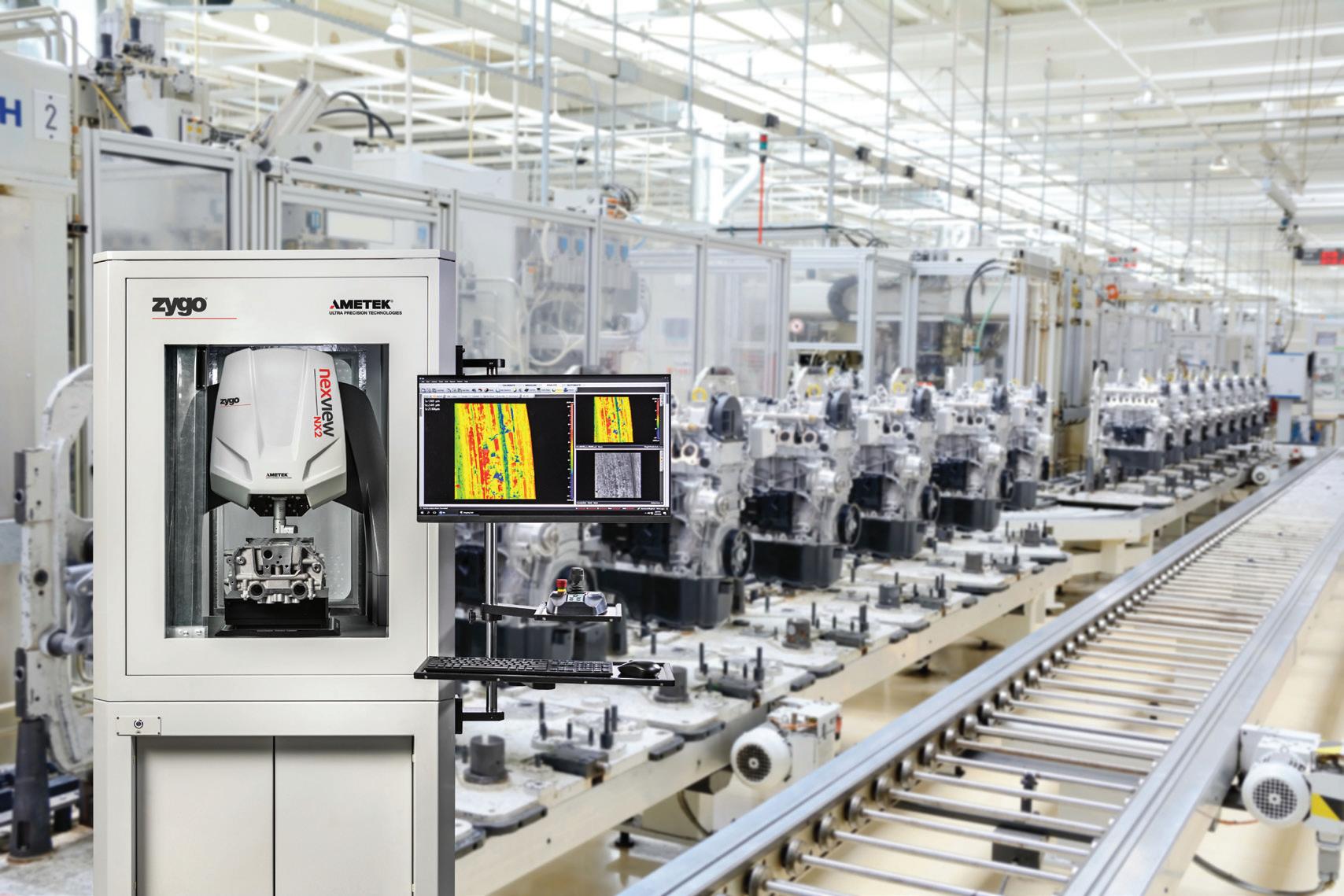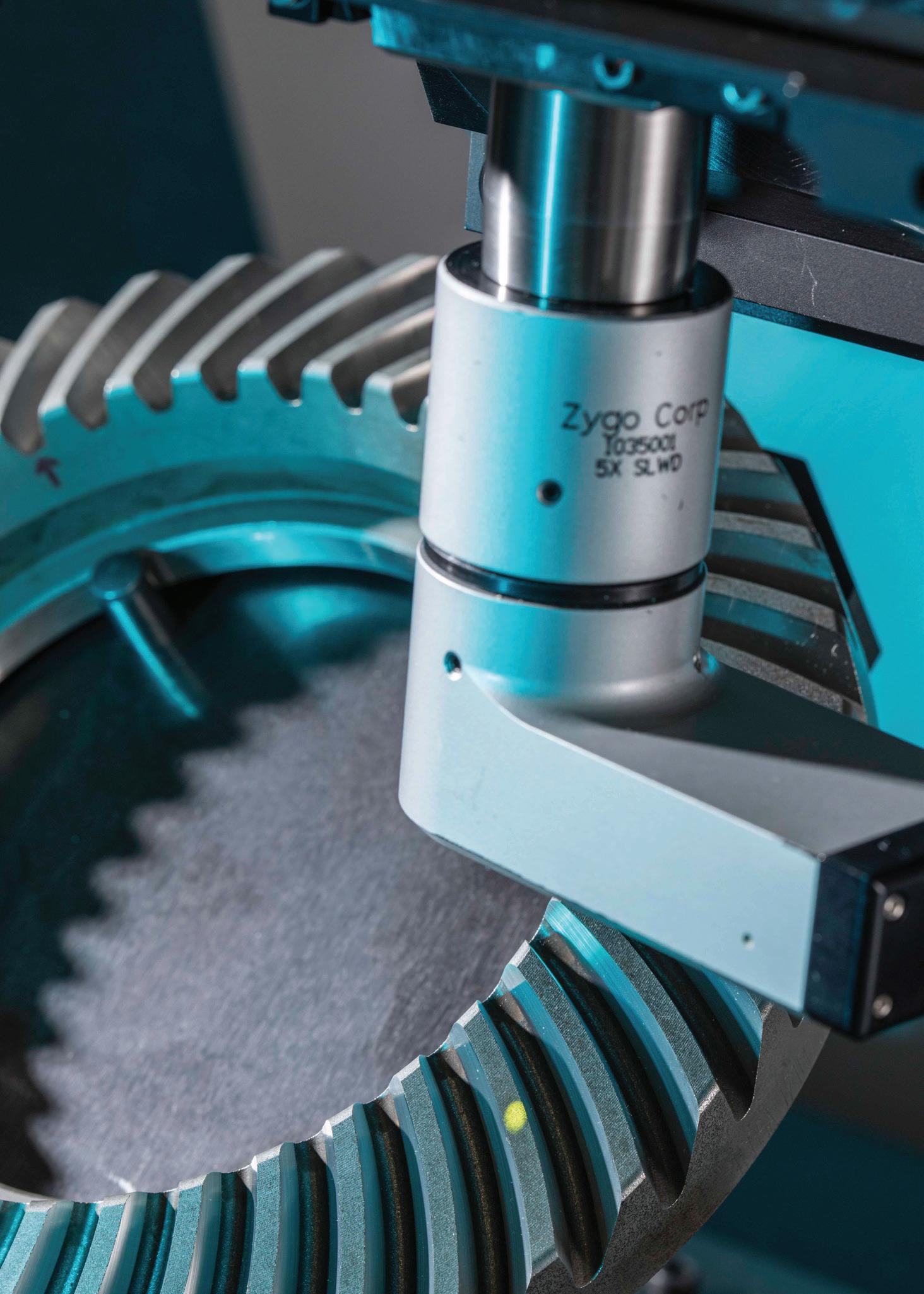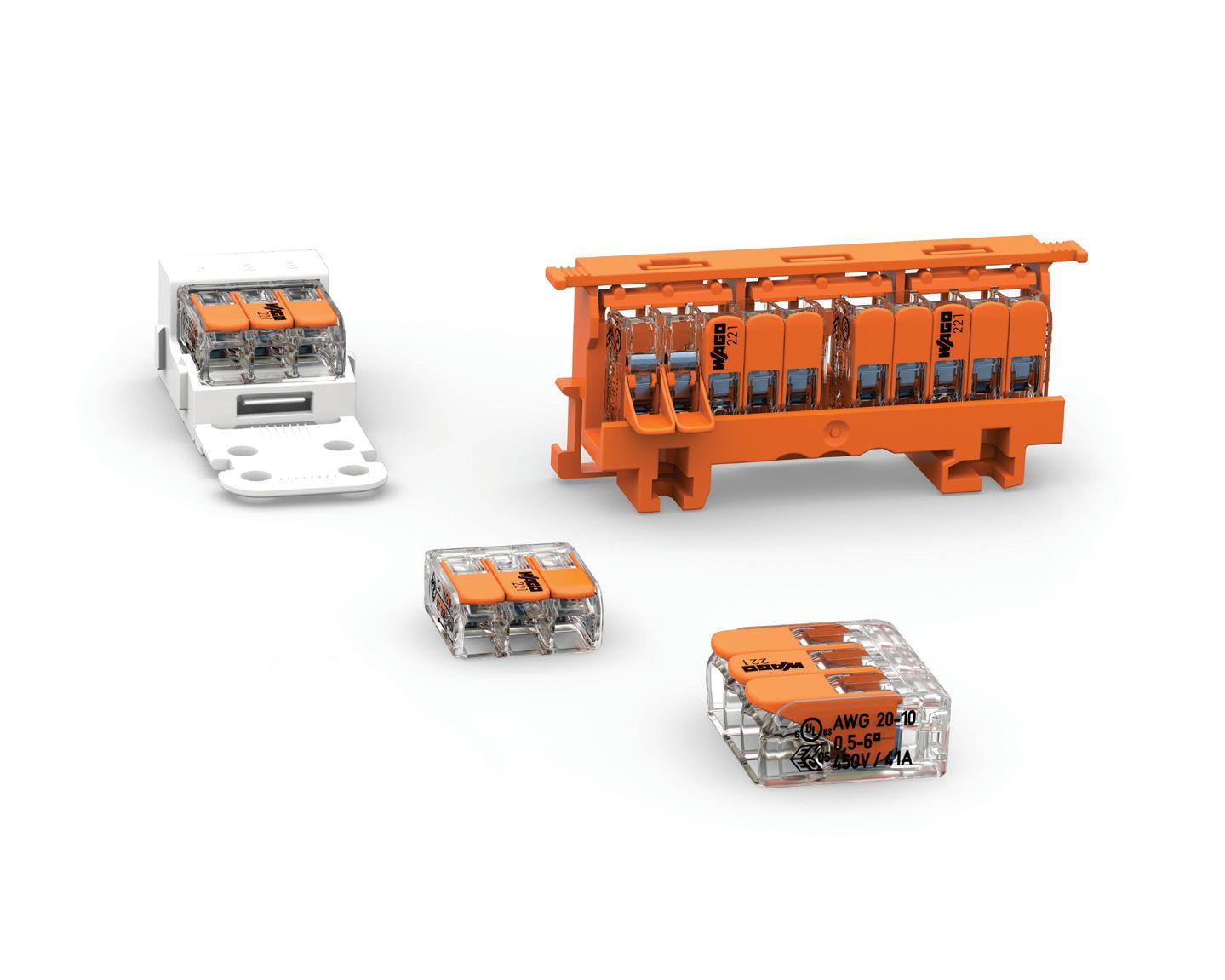
11 minute read
Internet of Things
Metrology and Industry 4.0
Dr Peter J. de Groot, Executive Director of R&D & Michael Schmidt, Market Development Manager Zygo Corp.
When looking at the place of metrology in the “Fourth Industrial Revolution,” it is interesting to ponder whether industry 4.0 is being driven by developments in metrology or metrology developments are being driven by Industry 4.0. Today’s most sophisticated metrology systems drive quality assurance (QA) which has become a fundamental digital task, which in and of itself, facilitates e cient and cost-eff ective production processes. QA data today controls how products are made, and drives the bottom line and the repeatability in production that is vital in all panindustrial manufacturing scenarios. From this perspective, it is a short leap to advocate that QA drives Industry 4.0. The dynamic growth of non-contact 3D optical metrology solutions in recent years reinforces this argument, as image processing and vision systems easily fi t into Industry 4.0 processes. And so, we begin to shi preconceptions. For a long time, metrology for production QA has been seen as akin to a necessary evil, a part of the product development process that ticks boxes but doesn’t directly add value. From this angle, it can be argued that metrology serves no other purpose than to catch failures within a production process. If the failures or short comings were not there, then the role of metrology would be redundant. But in the modern world, metrology is the source of bucket loads of data, which can be used to fuel the systems used in a smart factory or Industry 4.0 environment, promoting true data-driven production.
Drilling into Industry 4.0 A key competitive driver for manufacturers is e cient production, which is why Industry 4.0 solutions using digital technologies to stimulate innovation and improve production processes are gaining traction across all key industrial sectors.
As these technologies are enhanced and become less expensive, Industry 4.0 will become more important. The underpinnings of the concept of Industry 4.0 requires that businesses interrogate their competitive model and focus on increasing capacity to deliver more cost-eff ective products through the digitization of the entire production process. This task requires businesses completely re-assess their entire value chains, and apply diff erent ways of thinking and toolsets, fusing the physical, digital, and virtual worlds together. Industry 4.0 encourages the integration of intelligent production systems and advanced information technologies, and is fundamental to the foundations and future of many of the world’s leading manufacturers. The promotion of a digital manufacturing strategy is fundamental for many manufacturing companies if they are to remain competitive in the years to come. and central to this is the capture, analysis, and alteration of data. From this perspective, the role of 3D metrology solutions is clear, and it is much more than just catching the occasional QA failure in production.
The power of metrology driven data For Industry 4.0, use of big data is key, as is its movement and use upstream and downstream in the product development process, with algorithms adjusting the manufacturing process to ensure consistent, e cient, and above all repeatable production with zero failure rates. 3D data captured as parts are manufactured using fast, non-contact optical metrology systems can be directly fed to the quality control team who can analyze its conformance with design intent by comparing it with 3D CAD solid models. Any areas of concern can be highlighted, and adjustments can be made instantaneously to CAM fi les. Such an automatic process all but negates the need for shut-off , drastically reduces failure rates and scrap, and therefore enhances the overall e ciency and cost-eff ectiveness of production. In such a scenario, advanced 3D optical metrology solutions enhance the quality, quantity, and speed with which data are collected, and allows analysis and signifi cance to be assessed in the blink of an eye to the betterment of manufacturing processes.

Smart factory metrology solutions Metrology’s role in digitized factories that continuously collect and share
Internet of Things
data through inter-connected devices, machines, and production processes is to support digital production at every stage. To achieve the objectives of the “smart factory,” manufacturers must evolve their processes to close gaps in inspectionrelated data at every stage in production. It also has a role in giving manufacturers greater visibility of the entire supply chain, including suppliers. Smart factories bristling with industrial robots and automated handling systems rely disproportionately on fully automated control systems and speedy verifi cation and feedback. This plays to the use of in-process metrology solutions and non-contact 3D optical solutions. Typically, the conversation about the optimum use of metrology in manufacturing settings is between its use in the lab or in-process. Ultimately, a key driver for the shi om in-lab to in-process is a desire for a “faster time to data,” and the ability to make decisions as a result of that faster data. Hence, it is a key element of Industry 4.0 and the e cient running of a smart factory. When compared to alternative legacy metrology solutions where measurement is a separate off -line activity, in-process solutions have several advantages, the most obvious being the speed with which the derived data can infl uence decision making. If carrying out metrology in-lab, parts must be moved to the QC department, and then they need to be set-up for the metrology operation to be undertaken. If the metrology is in-line, various process steps are removed, and as defects and problems can be identifi ed and rectifi ed instantaneously, reworking is reduced. In-process metrology therefore assists in preventing problems before they arise, and if they do arise allows them to be identifi ed and addressed before they become a costly and time-consuming issue. Non-contact optical metrology solutions also fi t within the concept of Industry 4.0 as they are speedier and can cover larger areas than contact devices. Fully integrated 3D optical metrology promotes fully automated closed-loop production. In addition, improvements in computer processing and optical technology mean that the sheer amount of data acquired and analyzed is vastly increased. 3D optical metrology solutions used in-process allow for processed data to be to be fed om the metrology system into the factory management system and this advances the concept of the smart factory considerably. More intelligent, more fl exible, and faster learning metrology systems are at the heart of — and integral to — industry 4.0 and all advanced manufacturing systems. Such metrology systems promote the evolution of connected factories, and will dramatically reduce downtime while speeding up production of more innovative, better designed, and higher quality products. While there are many developments on the horizon in this area, metrology solutions that exist on the market today can be used to enhance manufacturing e ciency at all levels. DW

Zygo Corp., owned by AMETEK, Inc. www.zygo.com
Internet of Things
AI analytics for manufacturers
Brian McCarson • Vice President and Senior Principal Engineer at Intel Corporation
The use of artifi cial intelligence (AI) for the Industrial
Internet of Things (IIoT) is moving into broader adoption. Infl uenced by open-source communities, the AI domain is making advances quickly – moving om invention to mass replication in just weeks. To unlock potential AI benefi ts – discovering valuable insights, realizing e ciencies or gaining competitive advantage – manufacturers need tools that make it easy to perform analytics. Here are key steps to build these AI solutions in industrial settings, using a common use case: machine vision.
Leverage open-source AI innovations Lighting and camera resolution inconsistencies are a major hurdle to deploying vision-based analytics on the factory fl oor. The human eye can correct for diff erent lighting conditions easily, but images collected by a camera naturally vary in intensity and contrast when background lighting varies. Luckily, the open-source community is fueling democratization and rapid adoption of AI innovations. Members of the community share data, tools and methods that developers can adopt within days. Algorithms are being developed with the ability to absorb lighting variations and neutralize gamma intensity diff erences as lighting varies throughout the day or as lighting varies om location to location on the factory fl oor.
Create a closed-loop cycle of innovation In some machine vision cases, factory managers achieved skewed results om machine to machine because of lighting variations. For example, one machine might achieve high accuracy, low false-positive and false-negative rates while a nearby machine might crash when running the same AI application. Natural light infl uences om a skylight or dense clusters of light fi xtures above a machine might cause these variations. Fortunately, with the advent of deep learning techniques, algorithms are being developed to replicate the photo receptors in our eyes and neurons in our brains to absorb lighting variations and neutralize gamma intensity diff erences. This is one example of how the open-source community can rapidly deploy solutions to solve manufacturers’ challenges. An example of opensource so ware is the Intel Edge Insights for Industrial so ware and the Intel Distribution of OpenVINO toolkit to enable AI in industrial and other sectors. Such ee, ready-to-use analytics pipelines were developed for concurrent time-series and video workloads found in industrial applications. They are available in an easy-to-deploy, easy-to-modi , microservices amework. The so ware supports the acceleration and distribution of analytics on CPUs, GPUs, FPGAs (fi eld programmable gate arrays), VPUs (vision processing units) and Intel Optane memory.
Support open-source communities The AI market is being driven by exceptionally talented developers and open-source communities. Their innovations are pushing our collective knowledge and capabilities forward, daily. To make these AI innovations and deep learning techniques mainstream, we need to continue sharing tools and resources in ways that are easily accessible, usable, safe, secure, and proven to add value for engineers and managers on the factory fl oor. DW
Intel | www.intel.com
WHAT DO YOU THINK?
Connect and discuss this and other engineering design issues with thousands of professionals online
WAGO’s 221 Series Lever Nuts
Raising the bar for electrical applications
In true WAGO fashion, the manufacturer is continually innovating and improving its product offering. WAGO’s 221 Series Lever Nuts are an excellent example of this, representing the company’s answer to the twist-type splicing wire connector. This termination device quickly and easily connects different wire sizes and types, using 2, 3, and 5-wire connectors.
“A few years ago, WAGO developed the original 222 Series LEVER-NUTS®, which has been effective and successful,” shares Evan Syens, Product Manager, Electrical Splicing Connectors with WAGO Corporation. “However, innovation doesn’t stop for us just because a product has hit the market. We never settle for ‘good enough’ and are always striving for better. WAGO is all about ongoing advancements.”
To this end, WAGO created their newest version wire-connector solution, the 221 Series LEVER-NUTS®— and they’ve quickly become one of the company’s top-grossing products.
This is because with a typical twist-type connector, it’s impossible to know how secure the wire connections are for each terminal, which is a maintenance and safety concern.
“The clear housing completely takes the guesswork out of the installation process,” Syens explains. “Without it, how would you know how many twists are ideal for a secure connection? There’s room for error. In fact, installers will often secure wires with electrical tape to maintain the twist-type connection. But that’s unnecessary, thanks to WAGO’s innovation. Simply pull the orange lever up, insert a stripped conductor (according to the strip-length gauge on the side of the 221) and push the lever back down. That’s it. You’re done.”
Since every 221 Series LEVER-NUTS® also includes CAGE CLAMP® technology (the spring-pressured connection technology that WAGO pioneered back in the ’50s), installers can also ensure a secure a reliable connection. The CAGE CLAMP® is starting to become the industry standard for electrical interconnection technologies.
What’s more, is WAGO has incorporated test slots in the LEVERNUTS® Series for additional safety — one in the direction of wire insertion and one on the opposite side. This allows an installer to insert a test probe into the slots to determine if a wire is live.
“Another unique feature about these products is that they’re reusable, without any added steps. For example, there’s no need to re-strip the wires. Simply lift the lever and connect the new wires,” he says. “Again, it’s that simple.” WAGO’s 221 Series Lever Nuts

WAGO offers two different versions of the 221 Series: • The original variant: 24-12 AWG • The 10 AWG variant: 20-10 AWG
“The 20 to 10-gauge version also has three variants — a 2, 3, and 5-conductor, which goes up to 600 volts and 30 amps. And, as for the operating temperature, each variant is approved to 105° C,” says Syens.
Along with these innovative connectors, WAGO also offers a line of mounting carriers that can be mounted onto a DIN Rail or chassis, easily cleaning up your cabinet, panel, or junction box.
“It’s really about peace of mind because with CAGE CLAMP® technology, you can be confident in a secure connection for your application,” says Syens.
Whether for an electrical contractor, DIY home projects, lighting applications or use in hazardous locations, WAGO’s 221 LEVER-NUTS® Series offers fast, safe, and dependable connection technology.
Features of the 221 Series • Terminate conductors from 24–10 AWG (with two models: 24-12 AWG and 20-10 AWG) • Connect solid, stranded, and fine-stranded conductors • Combine different wire sizes and types • Install devices with higher levels of power consumption • Save time connecting wires without the use of tools








